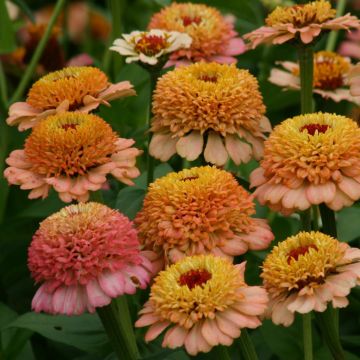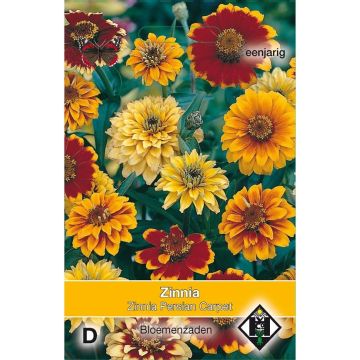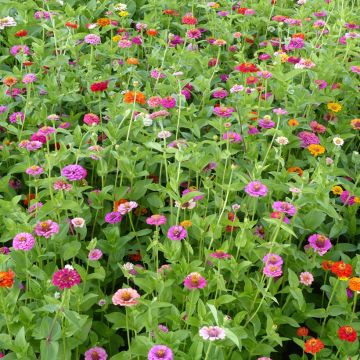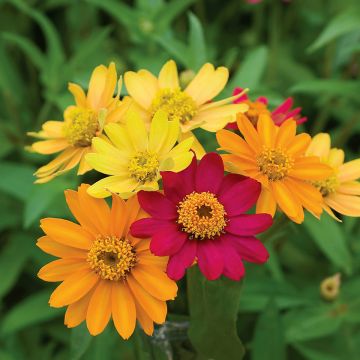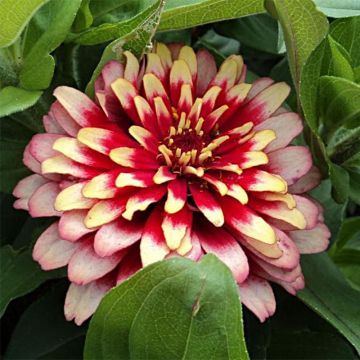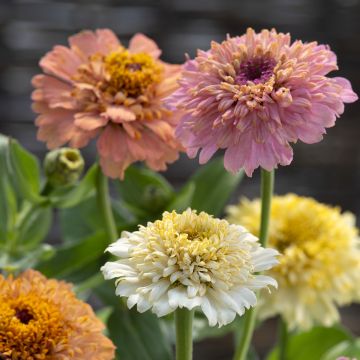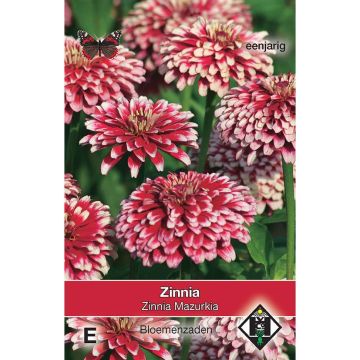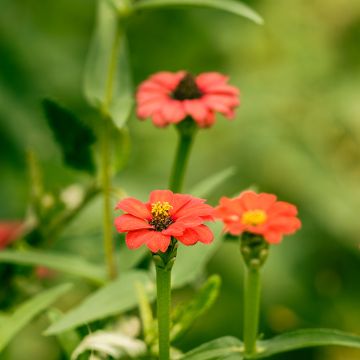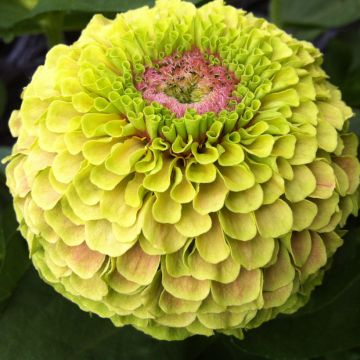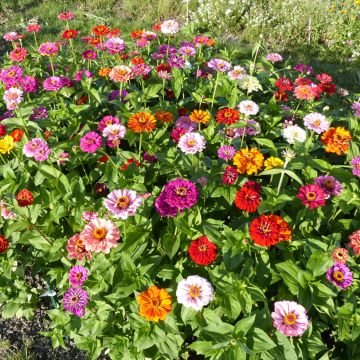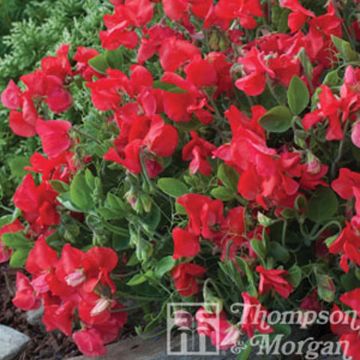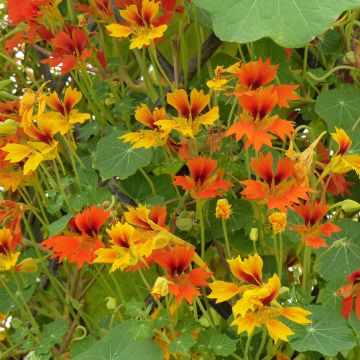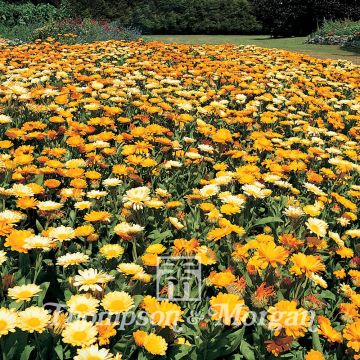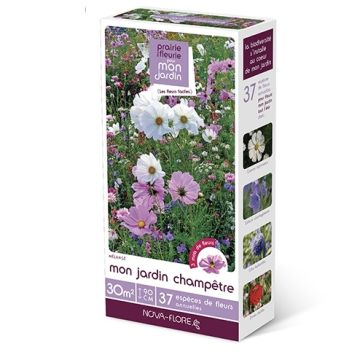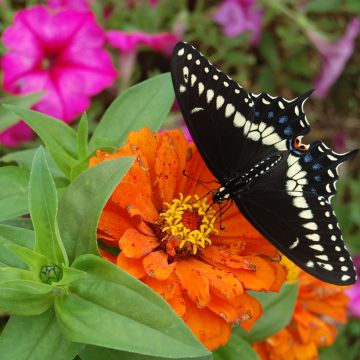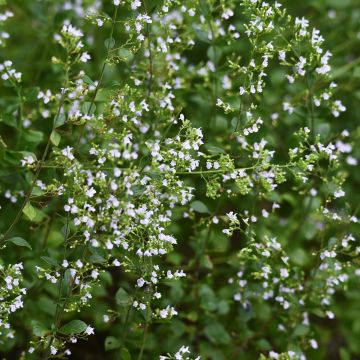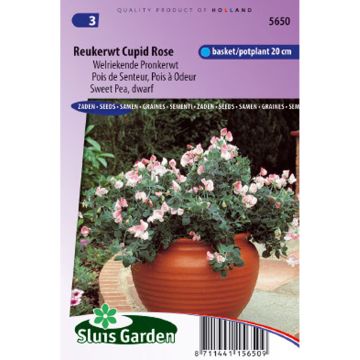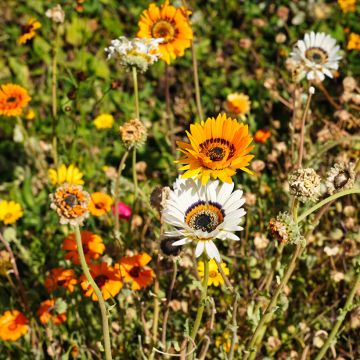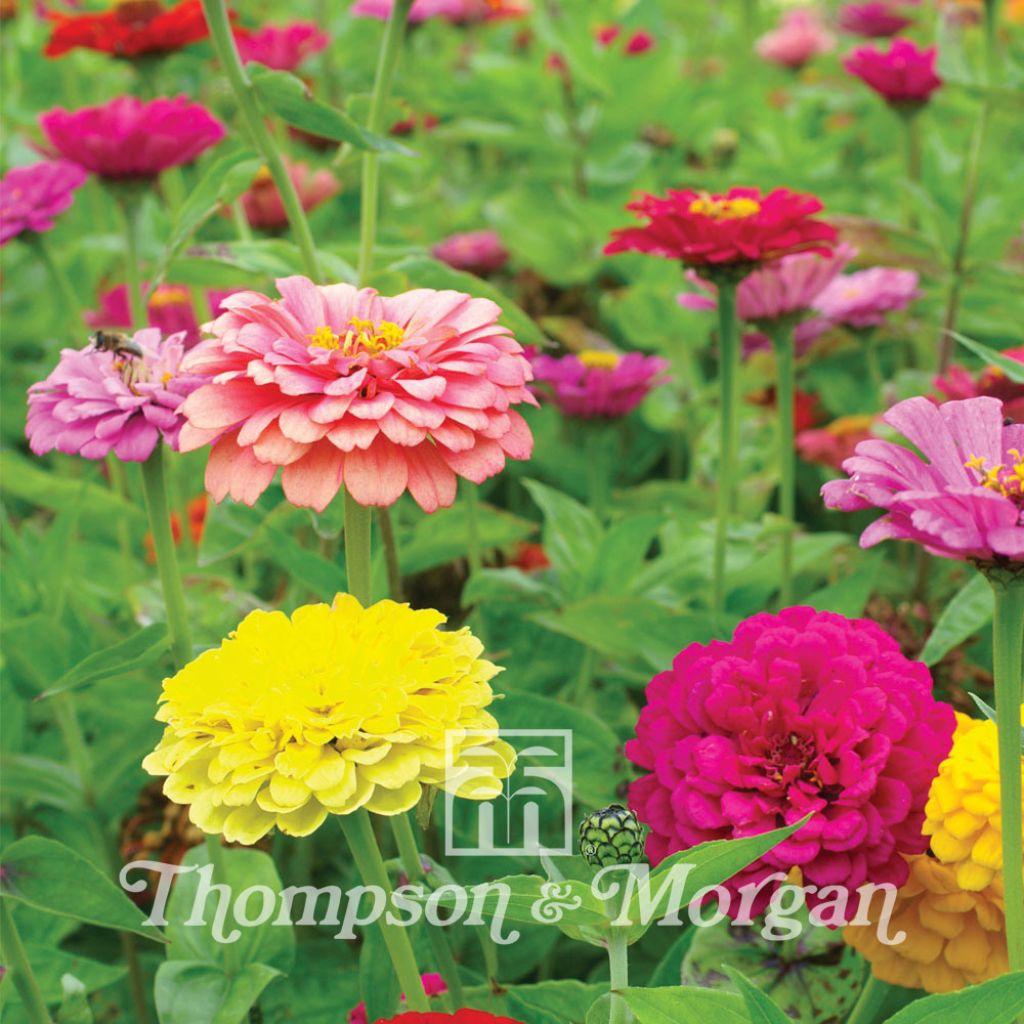

Zinnia elegans Giant Double Mixed Seeds
Zinnia elegans Giant Double Mixed Seeds
Zinnia x elegans Giant Double Mixed
Zinnia, Common Zinnia
Why not try an alternative variety in stock?
View all →This plant carries a 6 months recovery warranty
More information
We guarantee the quality of our plants for a full growing cycle, and will replace at our expense any plant that fails to recover under normal climatic and planting conditions.
Seed-only orders are dispatched by sealed envelope. The delivery charge for seed-only orders is €3.90.

Does this plant fit my garden?
Set up your Plantfit profile →
Description
Zinnia elegans 'Giant Double Mixed' is a variety of tall Zinnia that bears large double flower heads all summer long. Vigorous and heavy blooming, you will appreciate its great blend of colours as much as the perfect symmetrical shape of its blooms. This is a must in the garden and is absolutely magnificent in bouquets.
Much appreciated for their sturdiness, striking colours and ease of cultivation, Zinnias are a valuable asset in any garden. Zinnia elegans 'Giant Double Mixed' is a tall Zinnia that measures 75 cm high and 40 cm wide. The flowers are arranged in capitula (flower heads) measuring 11 cm across, and have a very structured appearance that adds a sophisticated touch to bouquets. You can easily combine it with Rudbeckia hirta Green Eyes and Lupin Morello Cherry within a colourful bed or the vegetable garden.
Native to an area spanning from the Southern United States to Argentina and belonging to the family Asteraceae, Zinnia is a herbaceous annual plant. It bears vigorous, bright, solid coloured flowers on straight, upright stems, which vary in size and shape from variety to variety. Its leaves are linear to oval, pointed and of a beautiful medium green colour. Zinnia flowers from July onwards, blooming generously up until the first frosts. It is a nectar-rich plant, adored by bees and butterflies.
Zinnia likes sun and tolerates strong heat well, provided it is watered every once in a while. It performs best in neutral, rich, well-drained soil. It is quite undemanding, adapting to any average garden soil.
Faded flowers should be removed regularly to encourage and sustain a lengthy flowering period. Easy to grow, it can occasionally be prone to powdery mildew; an inconvenience that can be easily avoided by not overcrowding plants, planting them in situations with good air circulation, and by taking care not to wet its foliage.
Report an error about the product description
Flowering
Foliage
Plant habit
Botanical data
Zinnia
x elegans
Giant Double Mixed
Asteraceae
Zinnia, Common Zinnia
Cultivar or hybrid
Other Zinnia seeds
Planting and care
Direct sow Zinnia seeds from April to May, in warm soil that has been raked to a fine tilth. Do not bury the seeds too deeply (3 mm is sufficient) and space them 30 cm apart. Keep the soil moist until germination which usually takes between 7 and 14 days.
For an early flowering, sow from March to April (indoors, at a temperature between 15 and 25 °C) in a seed tray filled with a good quality seed compost that should be kept moist but not waterlogged. When the plants are large enough to be handled, prick them out into pots. Gradually acclimatize your Zinnias to cooler conditions for a fortnight or more before planting them out in the garden, once all risk of frost has passed. Space the plants 30 cm apart.
Zinnia likes sun and tolerates strong heat well, provided they are watered every once in a while. It performs best in neutral, rich, well-drained soil. It is quite undemanding, adapting to any average garden soil. It can occasionally be prone to powdery mildew; an inconvenience that can be easily avoided by placing it in spots with good air circulation and taking care not to wet its foliage when watering. Once planted, be mindful of the voracious appetite of slugs which are fond of their young tender leaves.
Sowing period
Intended location
-
, onOrder confirmed
Reply from on Promesse de fleurs
Flower seeds
Haven't found what you were looking for?
Hardiness is the lowest winter temperature a plant can endure without suffering serious damage or even dying. However, hardiness is affected by location (a sheltered area, such as a patio), protection (winter cover) and soil type (hardiness is improved by well-drained soil).

Photo Sharing Terms & Conditions
In order to encourage gardeners to interact and share their experiences, Promesse de fleurs offers various media enabling content to be uploaded onto its Site - in particular via the ‘Photo sharing’ module.
The User agrees to refrain from:
- Posting any content that is illegal, prejudicial, insulting, racist, inciteful to hatred, revisionist, contrary to public decency, that infringes on privacy or on the privacy rights of third parties, in particular the publicity rights of persons and goods, intellectual property rights, or the right to privacy.
- Submitting content on behalf of a third party;
- Impersonate the identity of a third party and/or publish any personal information about a third party;
In general, the User undertakes to refrain from any unethical behaviour.
All Content (in particular text, comments, files, images, photos, videos, creative works, etc.), which may be subject to property or intellectual property rights, image or other private rights, shall remain the property of the User, subject to the limited rights granted by the terms of the licence granted by Promesse de fleurs as stated below. Users are at liberty to publish or not to publish such Content on the Site, notably via the ‘Photo Sharing’ facility, and accept that this Content shall be made public and freely accessible, notably on the Internet.
Users further acknowledge, undertake to have ,and guarantee that they hold all necessary rights and permissions to publish such material on the Site, in particular with regard to the legislation in force pertaining to any privacy, property, intellectual property, image, or contractual rights, or rights of any other nature. By publishing such Content on the Site, Users acknowledge accepting full liability as publishers of the Content within the meaning of the law, and grant Promesse de fleurs, free of charge, an inclusive, worldwide licence for the said Content for the entire duration of its publication, including all reproduction, representation, up/downloading, displaying, performing, transmission, and storage rights.
Users also grant permission for their name to be linked to the Content and accept that this link may not always be made available.
By engaging in posting material, Users consent to their Content becoming automatically accessible on the Internet, in particular on other sites and/or blogs and/or web pages of the Promesse de fleurs site, including in particular social pages and the Promesse de fleurs catalogue.
Users may secure the removal of entrusted content free of charge by issuing a simple request via our contact form.
The flowering period indicated on our website applies to countries and regions located in USDA zone 8 (France, the United Kingdom, Ireland, the Netherlands, etc.)
It will vary according to where you live:
- In zones 9 to 10 (Italy, Spain, Greece, etc.), flowering will occur about 2 to 4 weeks earlier.
- In zones 6 to 7 (Germany, Poland, Slovenia, and lower mountainous regions), flowering will be delayed by 2 to 3 weeks.
- In zone 5 (Central Europe, Scandinavia), blooming will be delayed by 3 to 5 weeks.
In temperate climates, pruning of spring-flowering shrubs (forsythia, spireas, etc.) should be done just after flowering.
Pruning of summer-flowering shrubs (Indian Lilac, Perovskia, etc.) can be done in winter or spring.
In cold regions as well as with frost-sensitive plants, avoid pruning too early when severe frosts may still occur.
The planting period indicated on our website applies to countries and regions located in USDA zone 8 (France, United Kingdom, Ireland, Netherlands).
It will vary according to where you live:
- In Mediterranean zones (Marseille, Madrid, Milan, etc.), autumn and winter are the best planting periods.
- In continental zones (Strasbourg, Munich, Vienna, etc.), delay planting by 2 to 3 weeks in spring and bring it forward by 2 to 4 weeks in autumn.
- In mountainous regions (the Alps, Pyrenees, Carpathians, etc.), it is best to plant in late spring (May-June) or late summer (August-September).
The harvesting period indicated on our website applies to countries and regions in USDA zone 8 (France, England, Ireland, the Netherlands).
In colder areas (Scandinavia, Poland, Austria...) fruit and vegetable harvests are likely to be delayed by 3-4 weeks.
In warmer areas (Italy, Spain, Greece, etc.), harvesting will probably take place earlier, depending on weather conditions.
The sowing periods indicated on our website apply to countries and regions within USDA Zone 8 (France, UK, Ireland, Netherlands).
In colder areas (Scandinavia, Poland, Austria...), delay any outdoor sowing by 3-4 weeks, or sow under glass.
In warmer climes (Italy, Spain, Greece, etc.), bring outdoor sowing forward by a few weeks.

































